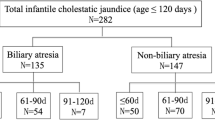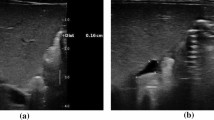Abstract
As simple and nonsurgical means of differentiating biliary atresia (BA) from intrahepatic cholestasis of unknown origin (IC), liver function tests including serum lipoprotein-X (LP-X) and γ-glutamyltranspeptidase (GGTP) were done and evaluated for their usefulness in the diagnosis of 27 cholestatic Japanese young infants. Except for LP-X and GGTP levels (P<0.01, P<0.001), there were no significant differences between the BA (n=11) and IC (n=13) groups. When values of mean plus 4 standard deviations were used to differentiate BA from IC (89 mg/100 ml for LP-X and 194 IU/l for GGTP), all BA patients gave positive results for either the crtical LP-X of GGTP values. On the other hand, all IC patients gave negative results for both levels, although patients with a paucity of intrahepatic biliary ducts (n=3) were also positive for either the critical LP-X or GGTP values. The combination test with serum LP-X and GGTP is recommended for helping to differntiate BA from IC in cholestatic young infants.
Similar content being viewed by others
Abbreviations
- BA:
-
biliary atresia
- IC:
-
intrahepatic cholestasis of unknown origin
- LP-X:
-
lipoprotein-X
- GGTP:
-
γ-glutamyltranspeptidase
- PIBD:
-
paucity of the intrahepatic bile duct
References
Alvarez AF, Yvart J, Odievre M (1981) The rose bengal test in neonatal cholestasis: Diagnostic and prognostic value. Eur J Pediatr 137:27–29
Fung KP, Lau SP (1985) γ-glutamyltranspeptidase activity and its serial measurement in differentiation between extrahepatic biliary atresia and neonatal hepatitis. J Pediatr Gastroenterol Nutr 4: 208–213
Hashiguchi Y, Kawaguchi M, Nakanishi M, et al. (1982) Simple, direct measurement of lipoprotein-X in serum. Clin Chim 28:606–608
Hays DM, Woolley MM, Snyder WH, Reed GB, Gwinn JL, Landing BH (1967) Diagnosis of biliary atresia: Relative accuracy of percutaneous liver biopsy, open liver biopsy and operative cholangiography. J Pediatr 71:598–607
Javitt NB, Keating JP, Grund RJ, Harris RC (1977) Serum bile acid patterns in neonatal hepatitis and extrahepatic biliary atresia. J Pediatr 90:736–739
Kasai M (1980) Hepatic portoenterostomy and its modifications. In: Japan Medical Research Foundation (eds) Cholestasis in infancy. Its pathogenesis, diagnosis and treatment. University of Tokyo Press, Tokyo, pp 337–344
Lawson EE, Boggs JD (1974) Long-term follow-up of neonatal hepatitis: Safety and value of surgical exploration. Pediatrics 53: 650–655
Lubin BH, Baehner RL, Schwartz E, Shohet SB, Nathan DG (1971) The red cell perioxide hemolysis test in the differential diagnosis of obstructive jaundice in new born period. Pediatrics 48:562–565
Manolaki AG, Larcher VF, Mowat AP, Barrett JJ, Portman B, Howard ER (1983) The prelaparatomy diagnosis of extrahepatic biliary atresia. Arch Dis Child 58:591–594
Markowitz J, Daum F, Kahn EI, et al. (1983) Arteriohepatic dysplasia. I. Pitfalls in diagnosis and management. Hepatology 3:74–76
Manzato E, Fellin F, Baggio G, Walch S, Neubeck W, Seidel D (1976) Formation of lipoprotein-X. Its relationship to bile compounds. J Clin Invest 57:1248–1260
Mashige F, Imai H, Osuga T (1976) A simple and sensitive assay of total bile acids. Clin Chim Acta 70:79–86
Mowat AP (1981) Pediatric liver disease. In: Arias IM, Frenkel M, Wilson JHP (eds) The liver. Amsterdam Oxford Princeton, Excerpta Medica, pp 210–235
Poly JR, Alaupovic P, McConathy WJ, Seidel D, Roy CC, Weber A (1973) Diagnosis of extrahepatic biliary obstruction in infants by immunochemical detection of LP-X and modified 131I-rose bengal excretion test. J Lab Clin Med 81:325–341
Ritland S, Bergan A (1975) Plasma concentration of lipoprotein-X (LP-X) in experimental bile duct obstruction. Scand J Gastroenterol 10:17–24
Tazawa Y, Konno T (1980) Semiquantitative assay of serum lipoprotein-X in differential diagnosis of neonatal hepatitis and congenital biliary atresia. Tohoku J Exp Med 130:209–217
Thaler MM, Gellis SS (1968) Studies in neonatal hepatitis and biliary atresia. I. Long-term prognosis of neonatal hepatitis. Am J Dis Child 116:257–261
Wright K, Cristie DL (1981) Use of γ-glutamyltranspeptidase in the diagnosis of biliary atresia. Am J Dis Child 135:134–136
Yeung CY (1972) Serum 5′-nucleotidase in neonatal hepatitis and biliary atresia: Preliminary observations. Pediatrics 50:812–814
Author information
Authors and Affiliations
Rights and permissions
About this article
Cite this article
Tazawa, Y., Yamada, M., Nakagawa, M. et al. Significance of serum lipoprotein-X and gammaglutamyltranspeptidase in the diagnosis of biliary atresia. A preliminary study in 27 cholestatic young infants. Eur J Pediatr 145, 54–57 (1986). https://doi.org/10.1007/BF00441853
Received:
Accepted:
Issue Date:
DOI: https://doi.org/10.1007/BF00441853




